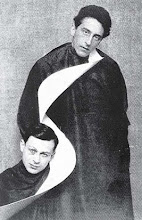skip to main |
skip to sidebar
Everything
wears off in this
world; and even the
comforting effect of ROBINSON CRUSOE wore off, after Penelope left me. I got fidgety again, and
resolved on making a survey
of the grounds before the rain came. Instead of taking the footman,
whose nose was human, and
therefore useless in any emergency, I took
the bloodhound with me. HIS nose for a stranger was to be depended on. We went all round the premises, and out
into the road—and returned
as wise as we went, having discovered no such
thing as a lurking human creature anywhere.
The
arrival of the carriages was the
signal for the arrival of the rain. It poured as if it meant to pour all night. With
the exception of the doctor, whose gig was waiting for him, the rest of the company went home snugly, under
cover, in close carriages. I told Mr. Candy that I was afraid he
would get wet through. He told me, in return, that he wondered I had arrived at
my time of life, without
knowing that a
doctor's skin was waterproof. So he drove away in the rain, laughing over his own little joke;
and so we got rid of our
dinner company.
The next thing to tell is
the story of the night.
Images: John Constable, Seascape Study With Raincloud, 1824.
Text: Wilkie Collins, The Moonstone, 1868.
Eugène Delacroix, A Mortally Wounded Brigand Quenches His
Thirst, 1825
DRESDEN.- For the conception and preparation of this exhibition Prof. Dr. Ulrich Bischoff, Director of the Galerie Neue Meister, enlisted the support of a renowned co-curator: Luc Tuymans (*1958), one of
the most influential contemporary painters. This Belgian
artist not only stands out on account of his impartial way of viewing art; for a
number of years now he has also taken on the role of curator.
John Constable (1776–1837), Eugène Delacroix (1798–1863), Caspar David Friedrich (1774–1840) and Francisco de Goya (1746–1828) were vital in
shaping modern art at the threshold of the 18th to
the 19th century and they had a formative
influence on the age of Romanticism in Europe.
Their outstanding paintings continue to serve as sources
of inspiration and visual instruction for the
generations of artists that have followed in their wake.
Caspar David Friedrich, The Gross Gehege near Dresden, 1832
In this special exhibition, Luc Tuymans and Prof. Dr. Ulrich
Bischoff trace the influence of these four
exceptional artists by presenting paintings by Paul Cézanne (1839-1906), Adolph Menzel (1815-1905), Édouard Manet (1832-1883), Mark Rothko (1903-1970) and Gerhard Richter (* 1932) alongside masterpieces of the Romantic period. Works by 16 artists are presented in sometimes surprising combinations, thus enabling historical references and contexts spanning some 200 years of art history to be explored from new perspectives.
Francisco Goya, The Little Giants, 1792
The idea at the core of the exhibition is to present the museum as both an artistic workshop and a source of inspiration. The curators
demonstrate that art does not come into being solely as the result of a creative
act in the artist’s studio, but can often be traced back to the artist’s direct engagement with freely chosen models from art
history.
John Constable, View Toward The Rectory From East Bergholt
House, 1813
Works on loan from international institutions including the Prado (Madrid), the Louvre (Paris), the Victoria & Albert Museum (London), the Statens Museum
for Kunst (Copenhagen), the Metropolitan
Museum of Art (New York), the Art Institute of Chicago, the Kunstmuseum Basel, the Bayerische Staatsgemäldesammlungen in
Munich, the Staatliche Museen zu Berlin, the Hamburger Kunsthalle, and from
private collections, will be shown alongside works from the holdings of the Galerie Neue Meister.
Luc Tuymans, Allo!—Social Housing, 2012
NOTE: I usually like
artist-curated art shows and am certain I would enjoy this Dresden exhibition. The press release is translated a little oddly from the German (e.g., I’m not sure what the writer means by an “impartial
way of viewing art”), but that's unimportant. The artists on view, including of course, the four focal geniuses, are always
worth our rapt attention. I have added two fine Luc Tuymans works immediately
above and below this note to help reader/viewers calibrate their senses.
As the press release writer says, artist curation definitely leads to “surprising
combinations” producing strange results. It may be a reach to
call Andrew Loog Oldham, former Rolling
Stones manager, Immediate Records owner, producer, author and raconteur extraordinaire an artist, but his
every day radio show curation on Underground Garage is
superb. Today, however, his juxtaposition of talentless Patti Smith’s ur-wretched Summer Cannibals and Aretha Franklin’s sublime Since You’ve Been Gone was a real Shock To
The Senses. I bear Patti Smith no ill will, but she remains a Yoko Ono-level musical artist, i.e., she writes terrible songs, can’t sing, and works with
a band who mostly can’t play. Unlike Ms. Ono, however, she is and always
has been a superb photographic model.
Patti
Smith -- Summer Cannibals (Link)
Aretha
Franklin -- Since You've Been Gone (Link)
Luc Tuymans, The Secretary of State, 2005


+DELACROIX.jpg)






